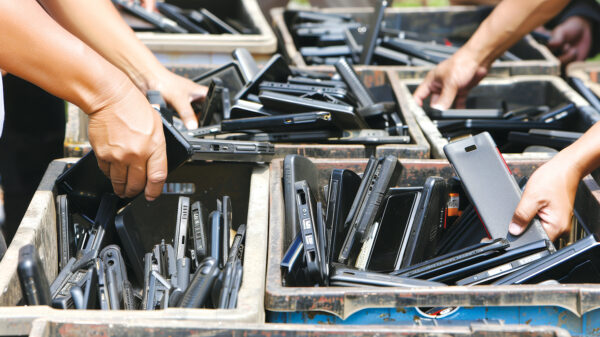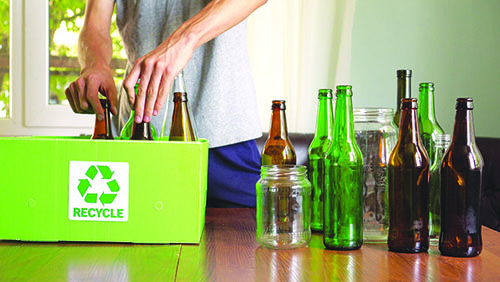by MAURA KELLER
According to the Aluminum Association, more than 75 percent of the aluminum ever made is still in use today because it can be recycled over and over again. Virtually all of the aluminum used in cars, buildings, airplanes and similar industrial products is recycled.
 Additionally, consumer products like beverage containers are recycled at far higher rates than competing packaging such as glass, plastic bottles or multi-layer composite containers. Regardless, around $800 million worth of aluminum is buried in landfills each year in the U.S. and is primarily aluminum cans.
Additionally, consumer products like beverage containers are recycled at far higher rates than competing packaging such as glass, plastic bottles or multi-layer composite containers. Regardless, around $800 million worth of aluminum is buried in landfills each year in the U.S. and is primarily aluminum cans.
While aluminum cans are the most recycled beverage package in the U.S. with a 10 to 20 point recycling rate advantage against glass and plastic, per the Aluminum Association, “the consumer recycling rate for aluminum cans, which measures the amount of domestic aluminum can scrap recycled as a percentage of cans available for recycling, declined significantly in 2016 to 49.4 percent.”
Here’s why: Like most recycled commodities, aluminum prices have declined in recent years. This drop in scrap price may have prompted sellers to hold onto the metal longer, waiting for prices to recover. When coupled with an even sharper decline in the all-in price for aluminum, scrap consumers may have also had more incentive to purchase and substitute other metal sources (primary or other secondary aluminum) into their stream.
According to Michael Jenny, managing director at Livingstone in Chicago and a member of Livingstone’s Global industrial team with a particular focus on metals and manufacturing sectors, the aluminum scrap market has been stagnant and prices are lingering at multi-year lows.
“In the primary scrap grades, price spreads are widening, meanwhile, secondary grades are abundant and demand is slow,” Jenny said. “Absent a major change in policies or production-driven demand, I suspect we’re near the bottom in terms of pricing.”
Ultimately this is a classic case of over supply for adequate demand. As Jenny explained, years ago there was concern about a shortage of aluminum, since then the industry met demand and we now have a glut of supply.
“The automotive industry is responsible for much of this shift, as the industry strives to meet the CAFE standards set forth in 2007 – under the current laws, passenger cars are required to reach 54.5 miles per gallon by 2026, so they’re building a voracious appetite for aluminum, that is not composed of majority recycled scrap,” Jenny said.
Aluminum sheet manufacturers also have shifted capacity towards higher-value automotive related products. As a result, capacity to fulfill other orders diminished, causing an influx in imports of finished sheets that eventually became scrap.
“This in turn resulted in a major glut in supply of scrap metal, which has significantly lowered prices,” Jenny said. “Overall, exports of UBCs are down 75 percent; the all-in price of aluminum is down $.17 to date. Moreover, historically wide spread means the all-in price of cans is, to use a technical term, super bad.”
Jenny said you can point at a few additional factors, including fewer people consuming soda, severe weather in different parts of the country impacting recycling, the automotive industry using, on average, less than 50 percent of recycled scrap aluminum, and the general lack of deposit legislation across many states.
“When scrap isn’t worth much, it’s not worth it for people to spend their days dragging it in,” Jenny said.
Legislative Efforts
To offset aluminum recycling (or the lack thereof) legislators have repeatedly introduced bottle bills (also known as container deposit laws), which some say, are proven, sustainable methods of capturing beverage bottles and cans for recycling. The refund value of the container (usually 5 or 10 cents) provides a monetary incentive to return the container for recycling. Only about 10 states have state beverage container deposit laws in place.
“Deposit bills could make a positive impact on the level of cans recycled,” Jenny said. “Simply put, when pricing drops, so does incentive for people to go out and pick up cans. States with deposit bills experience more recycling than states without deposit bills.”
In California, for example, the state’s Beverage Container Recycling Program is part of the California Beverage Container Recycling and Litter Reduction Act. Beverage containers covered under the act are subject to the California redemption value (CRV), which is $.05 for containers less than 24 ounces, $.10 for containers 24 ounces or larger. As a result of the CRV cash incentive, more than 300 billion aluminum, glass and plastic beverage containers have been recycled since the program began in 1987.
While Hawaii was the state to most recently pass a bottle deposit recycling bill in 2005, Arkansas recently filed a similar bill in March 2019. Of the two billion beverage containers consumed by Arkansans each year, roughly 70 percent of those bottles and cans ended up at landfills instead of recycling plants. Some of the bottles and cans simply end up on the side of the road.
“Arkansas spends $5 million a year picking up litter – that’s from the Department of Transportation,” said Arkansas State Representative Vivian Flowers (D-Pine Bluff), who filed the bill.
Landfill bans also are embraced by the Aluminum Association, which stated that, “Each year in the U.S. around $800 million worth of aluminum cans end up in landfills. This wasted value represents a loss to the environment and the overall economy. Cans aren’t trash.”
These UBCs are a valuable raw material stream for the aluminum industry, and the Aluminum Association supports legislation that keeps post-consumer used beverage cans out of landfills. Currently North Carolina and Wisconsin have landfill bans of aluminum cans in the hopes of building awareness among recycling companies and consumers.
So what does the future look like for aluminum recycling – specifically as it relates to aluminum cans? Aluminum use is better for the environment than glass or plastic. According to the Aluminum Association, a 2016 study by ICF International found that on a per liter beverage basis, emissions associated with transporting and cooling aluminum cans are 7 to 21 percent lower than plastic bottles and 35 to 49 percent lower than glass bottles, depending on the size of the comparative bottles as well as the types of refrigerators in which beverage is cooled prior to consumption. On a per container basis, the associated emissions of beverage packaged in a 12-oz aluminum can is 45 percent lower than in a 12-oz glass bottle and 49 percent lower than in a 20-oz plastic bottle when delivered and chilled in small markets and convenience stores.
Likewise, the recyclability of aluminum cans is unique in that they are most often recycled directly back into themselves. As the Aluminum Association explained, this means that aluminum cans have more than three times the recycled content than EPA estimates for glass or plastic, with 70 percent recycled content on average.
These benefits aside, monetary benefits (and any legal requirements) of recycling aluminum are what dictate the recycling efforts of consumers and recycling companies.
“We’re watching two trends that hold the potential to be important drivers for the aluminum recycling industry going forward,” Jenny said. “We’re closely watching demand response from increased domestic production which should soak up additional scrap supply which should, in turn stabilize pricing. Moreover, the anticipated shift by global brands from plastic bottles to aluminum will increase demand for aluminum, recycled and otherwise. Frankly, all things being equal, setting aside that London Metal Exchange (LME) pricing is directionally driven by global GDP, these two drivers are likely to have a mitigating effect on the current oversupply in the North American market.”
Published in the September 2019 Edition







